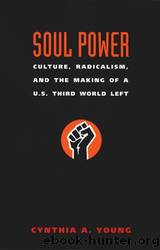Soul Power: Culture, Radicalism, and the Making of a U.S. Third World Left by Cynthia A. Young

Author:Cynthia A. Young [Young, Cynthia A.]
Language: eng
Format: azw3, mobi
Tags: Social Science, African American & Black Studies, History & Theory, General, United States, American, Political Science, Ethnic Studies, History
ISBN: 9780822336792
Publisher: Duke University Press
Published: 2006-11-01T15:06:42.837574+00:00
5. Attica prisoners corralled by police. Still from Teach Our Children provided courtesy of Third World Newsreel.
Even a wholly symbolic statement of political or cultural independenceâsuch as the flag held by the slain inmateâmust be swiftly and violently eradicated.
The surviving inmates tell of troopers who murdered or brutally punished inmates as they surrendered, accounts that are supported by mainstream media accounts of the incident. Unlike those reports, though, the prisonerâs testimony crackles with righteous indignation and anger. As one of the leaders recalls, he and fifty-nine other inmates were stripped, marked with an X, and made to crawl around the muddy perimeter during a downpour. As he describes this episode, the film juxtaposes footage of the Attica aftermath with still photography of World War II concentration camp victims and drawings of enslaved Africans on Southern plantations.
With this extreme juxtaposition, Attica is elevated to the level of a historic tragedy comparable, in the filmmakersâ discourse, to Hitlerâs crusade against the Jews and every bit as central to a communityâs collective memory. Claiming Atticaâs parity with the Holocaust is both politically loaded and audacious considering white Americans have historically resisted any attempt to compare their treatment of enslaved Africans and the Naziâs treatment of the Jews.
Though it is clearly inaccurate to compare Attica and the Jewish Holocaustâ
on the level of scale and sheer horror the Jewish Holocaust far surpasses Atticaâthe comparison highlights the insuâcient value placed on black American life. It also labels enslavement a genocidal practice. In addition, the film asks the viewer to consider how valuable prisoner lives are, and if they are indeed valuable, then what is civil societyâs responsibility in preventing future T H I R D W O R L D N E W S R E E L
1 7 1
Atticas. The comparison forces the viewer to confront the everyday forms of racist state violence that go unmarked and unresisted by its beneficiaries and raises the hope that future generations may view Attica in terms no less harshly than they do the Jewish Holocaust. This is, of course, wishful thinking as race and class oppression militate against the memorializing of the black and Latino victims of Attica.
However bloody the suppression of the Attica rebellion was, Teach Our Children refuses to dwell on the rebellionâs defeat. Instead, the film alludes to the militant action Attica may ultimately inspire in urban communities around the United States. To the upbeat, soul-inflected gospel anthem ââLet Us Sing This Simple Song for Freedom,ââ Teach Our Children argues that the spirit of Attica thrives in individual and collective memory. Shots of inmates pump-ing iron in U.S. jails alternate with shots of massing guerrilla armies in Southeast Asia, Latin America, and Africa. The voices of women and children intone,
ââWe the people here donât want no more,ââ while Malcolm Xâs voice excoriates U.S. imperialism: ââThey are violent when their interests are at stake, all that violence that they display at the international level. When you and I want a little bit of freedom, weâre supposed to be nonviolent.
Download
Soul Power: Culture, Radicalism, and the Making of a U.S. Third World Left by Cynthia A. Young.mobi
This site does not store any files on its server. We only index and link to content provided by other sites. Please contact the content providers to delete copyright contents if any and email us, we'll remove relevant links or contents immediately.
| Anarchism | Communism & Socialism |
| Conservatism & Liberalism | Democracy |
| Fascism | Libertarianism |
| Nationalism | Radicalism |
| Utopian |
The Secret History by Donna Tartt(18797)
The Social Justice Warrior Handbook by Lisa De Pasquale(12115)
Thirteen Reasons Why by Jay Asher(8762)
This Is How You Lose Her by Junot Diaz(6741)
Weapons of Math Destruction by Cathy O'Neil(6110)
Zero to One by Peter Thiel(5657)
Beartown by Fredrik Backman(5570)
The Myth of the Strong Leader by Archie Brown(5395)
The Fire Next Time by James Baldwin(5220)
How Democracies Die by Steven Levitsky & Daniel Ziblatt(5106)
Promise Me, Dad by Joe Biden(5064)
Stone's Rules by Roger Stone(5005)
A Higher Loyalty: Truth, Lies, and Leadership by James Comey(4818)
100 Deadly Skills by Clint Emerson(4817)
Rise and Kill First by Ronen Bergman(4676)
Secrecy World by Jake Bernstein(4614)
The David Icke Guide to the Global Conspiracy (and how to end it) by David Icke(4594)
The Farm by Tom Rob Smith(4414)
The Doomsday Machine by Daniel Ellsberg(4390)
